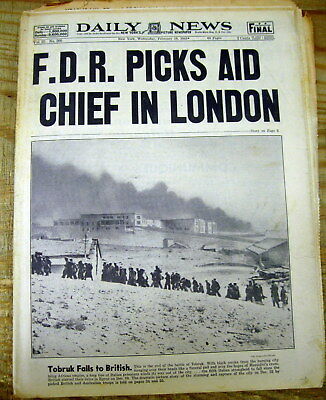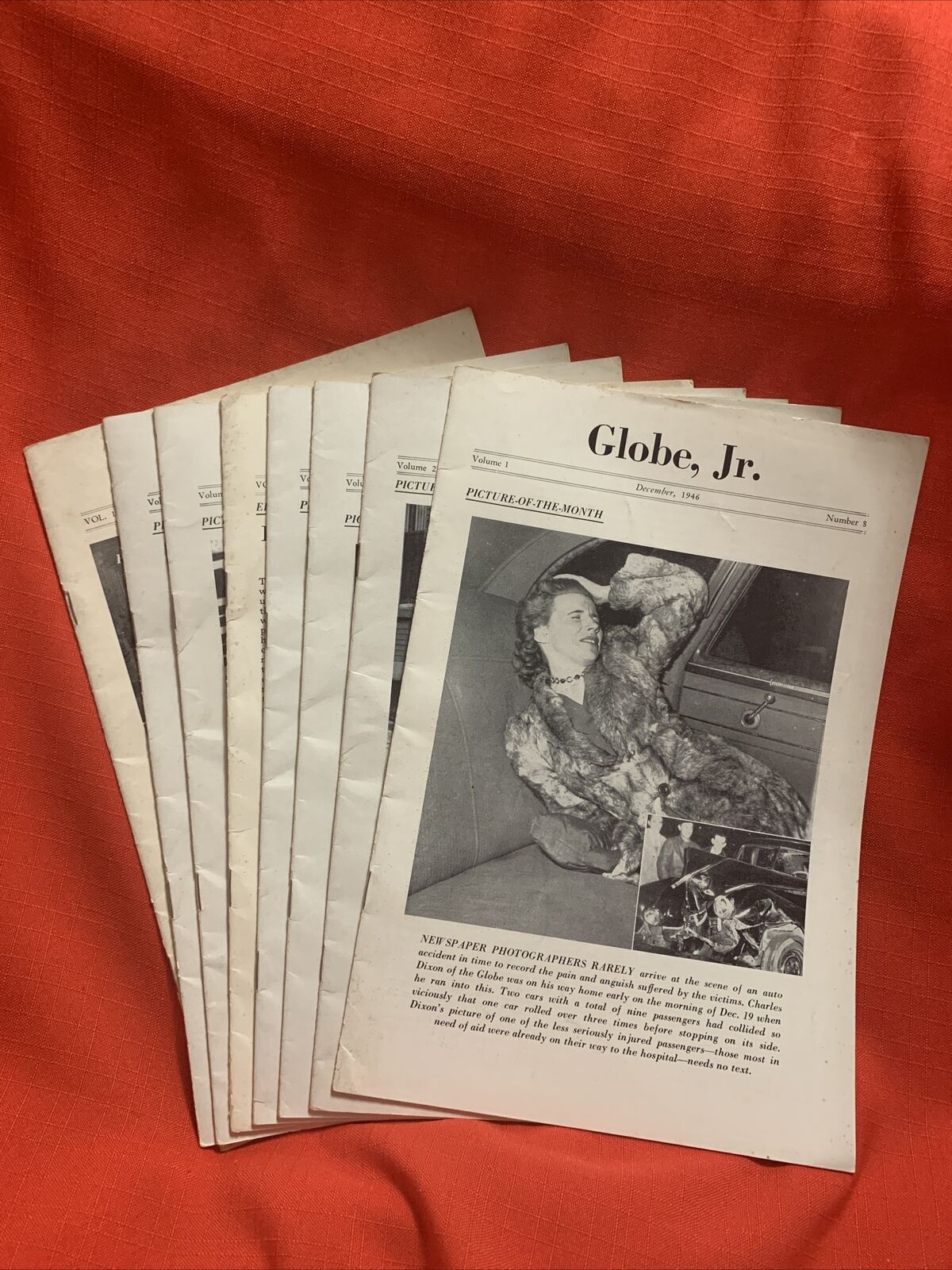-40%
1941 WW II NY Daily News newspaper BRITISH CAPTURE TOBRUK Libya from ITALY ARMY
$ 7.91
- Description
- Size Guide
Description
1941 WW II NY Daily News newspaper BRITISH forces CAPTURE TOBRUK Libya from the ITALIAN ARMY and the SIEGE of TOBRUK BEGINS-
inv # 8W-211
SEE PHOTO----- An ORIGINAL NEWSPAPER, the
NY Daily News
dated Feb 19, 1941.
This newspaper contains a large dramatic front page photo and inside page news coverage of the
BRITISH capture of TOBRUK, Libya from Italian forces in WW II.
This would mark the beginning of the SIEGE of TOBRUK by German and Italian forces that went on for nearly 1 year.
This newspaper has 24 of the 68 called-for pages. The news pages are present but the sports and comic sections are lacking.
On the morning of 5 January 1941, as soon as the 63rd Infantry Division Cirene garrisoning Bardia, surrendered, the 7th Armoured Brigade set off for El Adem (now Tobruk Airport) and next day began to cut off the port. (The Western Desert Force was renamed XIII Corps on 1 January.) The Australian 19th Brigade group reached the eastern defences of Tobruk on 7 January and the 16th Brigade group took over on the west side. The British 4th Armoured Brigade moved to the west part of the perimeter, the Support Group blocked the western exits and the British 7th Armoured Brigade screened the force from interference from the west, although little resistance had been met during the moves from Bardia. The Regia Aeronautica had lost many aircraft since Operation Compass began and the main repair depot at El Adem was captured, causing the Italians great difficulty in maintaining the serviceability of the remaining aircraft.
The attack was to be made against the perimeter east of the El Adem road, where a battalion of the 16th Australian Brigade was to capture the defences in a night attack, through which the rest of the brigade and the 7th RTR would pass and fan out east and west, then advance towards the harbour. The Australian 17th Brigade and the Support Group were to stage diversions either side of the attack and Italian artillery positions were to be located for counter-battery fire. Sandstorms blew up and grounded the Desert Air Force for much of the time but raids were carried out on Tobruk and the Italian bomber bases at Benina and Berka. On the night of 20/21 January, several ships and gunboats bombarded the harbour, destroyers waited further out to attack the Italian cruiser San Giorgio, if the crew tried to escape and then Wellington bombers flew over Tobruk, to drown the sound of the assembly for the attack.
The 2/3rd Australian Battalion attacked at 5:40 a.m. on 21 January, covered by artillery, through an area where engineers had disabled booby traps and then began to lift mines, to make paths through the wire and over the anti-tank ditch. After an hour, the 16th Australian Brigade and 18 infantry tanks broke through 1 mi deep on a 1 mi front, against patchy resistance. As the 16th Australian Brigade fanned out at 8:40 a.m., the 19th Australian Brigade advanced north, behind an artillery barrage and counter-battery fire on the Italian artillery. The 2/8th Australian Battalion was held up at the Bardia
–El Adem crossroads by a force of dug-in tanks and machine-gun nests but at 2:00 p.m. the Australians attacked again and broke through on the right. On the left, the Australians were counter-attacked by seven tanks and infantry behind an artillery barrage, which was driven off by the Australians, two anti-tank guns and two infantry tanks. More resistance was met near Pilastrino, which held out until 9:30 p.m. and the area around Solero was captured, along with the XXII Corps and garrison commander, General Pitassi Manella.
The 2/8th Australian Battalion had marched 20 mi
since the morning, fighting for 5 mi (8.0 km) and lost 100 casualties. During the day, Blenheims of 55 and 113 squadrons flew 56 sorties against Tobruk and the Gloster Gladiators and Hawker Hurricanes of No. 3 Squadron RAAF, No. 73 Squadron RAF and No. 274 Squadron RAF had patrolled to the west. Half of the Tobruk area had been captured by nightfall and the Italians began demolitions at the harbour. The San Giorgio, having been ordered to stay and help with the defence until the end, fired on the advancing Australian troops up to the time when the naval base fell, then was blown up by her crew to avoid capture. A general advance was ordered for the morning and at dawn, the commander of the Sirte Division, Major-General Della Mura surrendered with several thousand of his troops and the defence collapsed. The Australian 6th Divisional Cavalry Regiment reached the port and took the surrender of Admiral Massimiliano Vietina and the Regia Marina garrison. By 3:45 p.m. resistance had ceased and 20,000 prisoners, 208 guns and 87 tanks were captured. Another 18 officers and 750 Italian soldiers had been killed in the fighting and 30 officers and 2,250 men had been wounded. XIII Corps lost 400 men, 355 of them Australian. Most of the demolitions had been of stores rather than installations and the Inshore Squadron began mine sweeping and opened the port on 24 January.
The Siege of Tobruk lasted for 241 days in 1941, after Axis forces advanced through Cyrenaica from El Agheila in Operation Sonnenblume against Allied forces in Libya, during the Western Desert Campaign (1940
–1943) of the Second World War. In late 1940, the Allies had defeated the Italian 10th Army during Operation Compass (9 December 1940 – 9 February 1941) and trapped the remnants at Beda Fomm. During early 1941, much of the Western Desert Force (WDF) was sent to the Greek and Syrian campaigns. As German troops and Italian reinforcements reached Libya, only a skeleton Allied force remained, short of equipment and supplies.
Operation Sonnenblume (6 February – 25 May 1941), forced the Allies into a retreat to the Egyptian border. A garrison, consisting mostly of the 9th Australian Division (Lieutenant-General Leslie Morshead) remained at Tobruk, to deny the port to the Axis, while the WDF reorganised and prepared a counter-offensive. The Axis siege of Tobruk began on 10 April, when the port was attacked by a force under Generalleutnant Erwin Rommel and continued during three relief attempts, Operation Brevity (15–16 May), Operation Battleaxe (15–17 June) and Operation Crusader (18 November – 30 December). The occupation of Tobruk deprived the Axis of a supply port closer to the Egypt–Libya border than Benghazi, 560 mi west of the Egyptian frontier, which was within the range of RAF bombers; Tripoli was 930 mi to the west in Tripolitania.
The siege diverted Axis troops from the frontier and the Tobruk garrison repulsed several Axis attacks. The port was frequently bombarded by artillery, dive-bombers and medium bombers, as the RAF flew defensive sorties from airfields far away in Egypt. Allied naval forces, such as the British Mediterranean Fleet (including the Inshore Squadron) ran the blockade, carrying reinforcements and supplies in and wounded and prisoners out. On 27 November, Tobruk was relieved by the Eighth Army (which controlled British and other Allied ground forces in the Western Desert from September 1941) in Operation Crusader.
Good condition. This listing includes the original newspaper as described above, NOT just a clipping or a page of it. STEPHEN A. GOLDMAN HISTORICAL NEWSPAPERS stands behind all of the items that we sell with a no questions asked, money back guarantee. Every item we sell is an original newspaper printed on the date indicated at the beginning of its description. U.S. buyers pay priority mail postage which includes waterproof plastic and a heavy cardboard flat to protect your purchase from damage in the mail. International postage is quoted when we are informed as to where the package is to be sent. We do combine postage (to reduce postage costs) for multiple purchases sent in the same package.
We accept payment by PAYPAL as well as by CREDIT CARD (Visa and Master Card).
We list thousands of rare newspapers with dates from 1570 through 2004 on Ebay each week. This is truly SIX CENTURIES OF HISTORY that YOU CAN OWN
Stephen A. Goldman Historical Newspapers has been in the business of buying and selling historical newspapers for over 45 years. Dr. Goldman is a consultant to the Freedom Forum Newseum and a member of the American Antiquarian Society. You can buy with confidence from us, knowing that we stand behind all of our historical items with a 100% money back guarantee. Let our 45+ years of experience work for YOU ! We have hundreds of thousands of historical newspapers (and their very early precursors) for sale.










